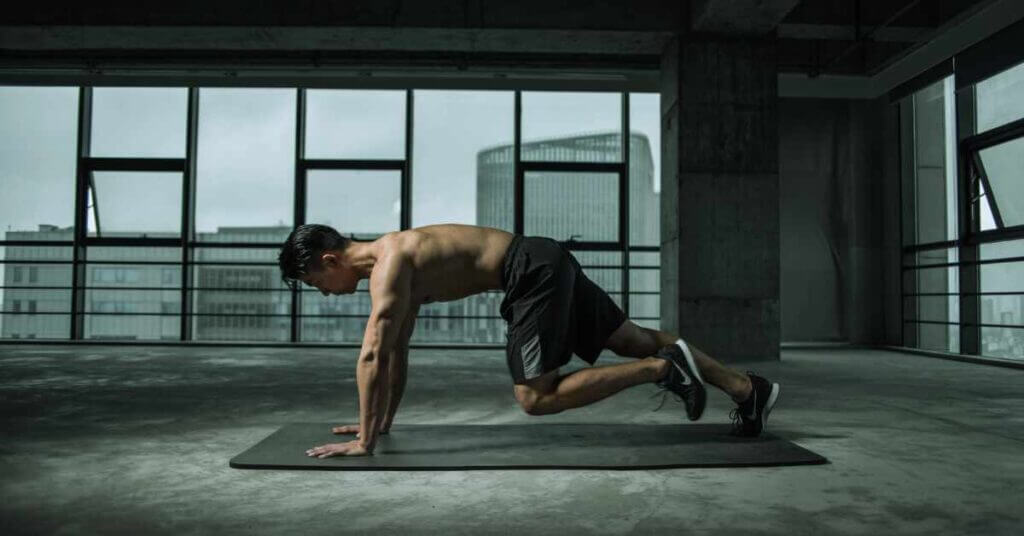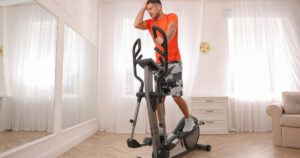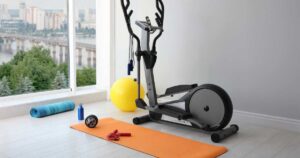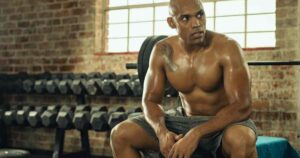List of 5 Must-Try Exercises that Start with V (How To Perform, common mistakes to avoid, tips, Intensity level, Muscles Worked, Average Calorie Burn, safety precautions)
Welcome to Cobra Fitness, In today’s article, we are going to dive into a thrilling alphabet challenge. We are going to explore 5 exercises that start with the letter V.
These 5 must-try exercises are not only going to help you to reach your fitness goals but they will also inject some excitement into your workout routine.
From targeting different muscle groups to offering varying intensity levels and contributing to an average calorie burn. In short, these exercises have everything that you need to achieve your fitness goal.
So grab a seat and let us show you how these exercises that start with V can elevate your fitness game.
5 Must-Try Exercises That Start With V
- V-Ups
- Vertical Leg Crunches
- Vertical Chest Press
- Viking press
- Vinyasa Flow Yoga
V-Ups
V-Ups are a challenging abdominal exercise that targets your core muscles, giving you a strong and toned midsection. This exercise is named after the shape your body creates when performing it – resembling the letter “V”.
How To Perform:
- Lie flat on your back with your legs extended and arms stretched overhead.
- Engage your core muscles by drawing your belly button towards your spine.
- Simultaneously lift your legs off the ground while raising your upper body towards them.
- Keep reaching for your toes as you form a “V” shape with your body.
- Hold this position for a brief moment, focusing on contracting your abdominal muscles.
- Slowly lower yourself back down to the starting position with control.
Common Mistakes to Avoid While Doing V-Ups:
- One common mistake people make while doing V-ups is relying on momentum instead of engaging their core muscles. This means swinging your legs and using the momentum to lift your upper body off the ground.
- To avoid this, focus on controlled movements and use your abdominal muscles to initiate the movement.
- Another mistake is straining your neck by pulling it forward during the exercise. This not only puts unnecessary strain on your neck but also takes away from the effectiveness of the exercise for targeting your abs.
- Instead, keep your chin slightly tucked and maintain a neutral spine throughout the movement.
- Not Breathing Properly. Many people tend to hold their breath or take shallow breaths while performing V-ups, which can hinder performance and decrease oxygen supply to working muscles.
- Remember to inhale deeply as you lower yourself back down and exhale as you crunch up.
- Neglecting Form for Quantity. It’s important not to sacrifice proper form for quantity when doing V-ups. Focus on quality repetitions rather than trying to do as many as possible in a short amount of time.
- Maintain control throughout each rep and ensure that you are fully contracting and extending your abdominal muscles with each movement.
- Ignoring Modifications. Ignoring modifications can lead to poor form and an increased risk of injury during V-ups if you’re not yet strong enough or flexible enough for the full movement variation.
- If needed, start with modified versions such as bent knee v-ups or single-leg v-ups until you build sufficient strength and stability.
Tips to Maximize the Effectiveness of V-Ups:
- To maximize the effectiveness of your V-Ups, focus on engaging your core muscles throughout the entire exercise. This means maintaining a strong contraction in your abs and lower back as you lift your legs and upper body off the ground.
- Avoid using momentum or swinging motions to perform V-Ups. Instead, concentrate on controlled movements, ensuring that you lift and lower yourself slowly and with precision. This will help to target the specific muscles involved in the exercise.
- It’s crucial to maintain proper form during V-Ups to avoid strain or injury. Keep your back straight, shoulders relaxed, and neck aligned with your spine throughout the movement. Additionally, be mindful not to round or hunch your back as you crunch up.
- Don’t forget about proper breathing techniques while performing V-Ups! Inhale deeply as you lower yourself down and exhale forcefully as you contract your abdominal muscles to lift both legs and torso simultaneously.
- If you find that regular V-Ups have become too easy, challenge yourself by adding weights or resistance bands for added intensity.
- You can also try increasing the number of repetitions or including variations like bicycle kicks or Russian twists into your routine.
Intensity level:
When it comes to intensity, V-Ups packs a punch! This exercise targets your abdominal muscles and engages your core in a challenging way. The intensity level of V-Ups can be categorized as moderate to high.
The more control and precision you have while performing V-Ups, the higher the intensity becomes. It’s important to maintain proper form and engage your abs fully during each repetition for maximum effectiveness.
Muscle worked:
- The main muscle targeted is the rectus abdominis, commonly known as the “six-pack” muscles. This exercise specifically targets and strengthens these abdominal muscles, helping to develop core stability and improve overall posture.
- In addition to the rectus abdominis, other muscles that are activated during V-Ups include the hip flexors, particularly the iliopsoas muscle group. These muscles assist in lifting your legs off the ground towards your torso.
- Furthermore, V-Ups also engage the obliques – both external and internal – which are located on either side of your abdomen. These muscles play a crucial role in rotational movements of the trunk.
- The lower back muscles or erector spinae also come into action during V-Ups to provide support and help maintain proper spinal alignment throughout the exercise.
- Engaging in V-Ups can strengthen and tone your hip adductors (inner thighs) as they work together with other leg muscles to lift your legs upwards.
SEE ALSO: 5 MUST-TRY EXERCISES THAT START WITH K
Average Calorie Burn:
When it comes to burning calories, V-ups are a fantastic exercise that can help you achieve your fitness goals. But how many calories do you burn during this challenging move? Well, the exact number depends on several factors such as your weight, intensity level, and duration of the workout.
On average, a person weighing around 150 pounds can expect to burn approximately 100-200 calories in a 15-minute session of doing V-ups. However, if you increase the intensity or extend the duration of your workout, you may elevate the calorie burn even further.
To maximize calorie burn during V-up workouts, consider increasing the speed or adding resistance by using weights or resistance bands.
Vertical Leg Crunches
Vertical Leg Crunches is an exercise that targets the abdominal muscles, specifically the rectus abdominis. It is a variation of the traditional crunches that add intensity and challenges to your core workout routine.
How To Perform:
- Lie flat on your back with your legs extended upward, perpendicular to the floor. Place your hands behind your head or keep them crossed over your chest.
- Engage your core muscles by contracting your abdominal muscles and lifting your upper body off the floor. Simultaneously, lift both of your legs towards the ceiling while keeping them straight.
- As you crunch up, reach for your toes with your fingertips or try to touch them as close as possible without straining yourself.
- Hold the contraction briefly at the top of the movement and then slowly lower yourself back down to the starting position, ensuring a controlled descent.
- Repeat this exercise for a specific number of repetitions or until you feel fatigued in your abdominal muscles.
Common Mistakes to Avoid While Doing Vertical Leg Crunches:
- One common mistake is using momentum instead of engaging your core muscles. It’s important to focus on contracting your abs and lifting your shoulder blades off the ground rather than relying on swinging or jerking motions.
- Another mistake is pulling on your neck with your hands. This can strain the neck muscles and take away from the effectiveness of the exercise. Instead, place your hands lightly behind your head for support, but avoid pulling or tugging on your neck.
- It’s also important to keep a steady pace and avoid rushing through the movement. By taking slow, controlled repetitions, you’ll engage more muscle fibers and maximize results.
- Be mindful of keeping proper form throughout the exercise. Make sure to maintain a straight spine and avoid arching or rounding your back.
- Additionally, keep your legs at a 90-degree angle throughout the movement to target the abdominal muscles effectively.
Tips to Maximize the Effectiveness of Vertical Leg Crunches:
- Include Variations. To keep things interesting and challenge different muscle groups, consider adding variations such as side-to-side twists or adding weights to increase resistance.
- If you’re finding vertical leg crunches too challenging at first, start with bent knees instead of fully extended legs until you build up enough strength and flexibility for straight-leg variations.
- Remember to exhale as you contract your abs lift your shoulders off the ground, and inhale as you lower yourself back down.
- Slow and controlled movements are essential when doing vertical leg crunches. Avoid using momentum or swinging your legs up, as this can take away from the effectiveness of the exercise.
- Instead, focus on engaging your abdominal muscles to lift your legs while maintaining control.
- One of the key tips for performing better vertical leg crunches is to maintain proper form throughout the exercise. Make sure your lower back stays pressed against the floor and engage your core muscles as you lift your legs towards the ceiling.
Intensity level:
When it comes to the intensity level of Vertical Leg Crunches, it can be described as moderate to high. This exercise targets your abdominal muscles, specifically the rectus abdominis and obliques.
The intensity of Vertical Leg Crunches depends on various factors such as your fitness level, body weight, and technique. By lifting your legs off the ground and crunching upward towards them, you engage your core muscles more intensely compared to traditional crunches.
To increase the intensity of this exercise, you can try adding weights or resistance bands. This will challenge your muscles even further and help you build strength in your abs.
Muscle worked:
- The main muscle group that is engaged during this exercise is the rectus abdominis, commonly known as the six-pack muscles. This muscle runs vertically along the front of the abdomen and is responsible for flexing the spine.
- In addition to targeting the rectus abdominis, Vertical Leg Crunches also activate the internal and external obliques. These muscles are located on either side of the abdomen and play a crucial role in rotational movements of the torso.
- Performing Vertical Leg Crunches engages and strengthens the transverse abdominis. This deep-lying muscle acts as a stabilizer for your core and helps to maintain proper posture.
SEE ALSO: 5 MUST-TRY EXERCISES THAT START WITH E
Average Calorie Burn:
The average calorie burn during a session of Vertical Leg Crunches can vary depending on various factors such as body weight, intensity level, and duration of the workout.
On average, a person weighing around 150 pounds can expect to burn approximately 100-150 calories in a 30-minute session.
Keep in mind that this estimation is just a rough guideline, as individual calorie burn can differ based on metabolism and effort exerted during the exercise.
Vertical Chest Press
Vertical Chest Press is an effective exercise that targets the muscles in your chest, shoulders, and triceps. It can help you build upper body strength and improve your overall muscular endurance.
How To Perform:
- Start by adjusting the seat height of the chest press machine so that your feet are firmly planted on the ground and your knees are at a 90-degree angle.
- Sit down on the machine with your back pressed against the pad and grasp the handles with an overhand grip, slightly wider than shoulder-width apart.
- Keep your elbows bent at a 90-degree angle and in line with your shoulders.
- Push the handles forward while exhaling, extending your arms until they are fully extended but not locked out.
- Hold this position for a brief moment, feeling a contraction in your chest muscles.
- Slowly bring the handles back towards you while inhaling, allowing your elbows to bend again and return to the starting position.
Common Mistakes to Avoid While Doing Vertical Chest Press:
- One mistake to avoid is using too much weight. It’s important to start with a weight that you can comfortably handle and gradually increase as your strength improves.
- Using excessive weight not only compromises your form but also puts unnecessary strain on your muscles and joints.
- Another mistake is failing to maintain proper form throughout the movement. Keep your feet planted firmly on the ground, engage your core for stability, and focus on a controlled motion both during the lowering and lifting phases of the exercise.
- Avoid arching your back or allowing it to lift off the bench.
- Rushing through repetitions is a common mistake. Take your time with each rep, ensuring that you fully extend and contract your chest muscles with each repetition. Remember, quality over quantity!
- Neglecting proper breathing techniques can hinder results. Breathe in as you lower the weights towards your chest and exhale as you push them away from your body.
Tips to Maximize the Effectiveness of Vertical Chest Press:
- When performing the vertical chest press, it’s essential to maintain proper form throughout the exercise.
- Ensure that your back is straight, your shoulders are relaxed, and your feet are firmly planted on the ground. This will help target the chest muscles effectively and minimize strain on other areas of your body.
- Adjust Weight Accordingly. It’s important to choose a weight that challenges you but still allows you to maintain proper form. Start with a lighter weight and gradually increase as your strength improves.
- Using too heavy weights can lead to improper technique and potential injuries.
- Rather than rushing through each repetition, focus on slow and controlled movements during the vertical chest press exercise. This not only helps engage the targeted muscles more effectively but also reduces the risk of injury.
- Breathe Correctly. Inhale as you lower the weights towards your chest and exhale as you push them back up towards the starting position.
Intensity level:
The intensity level of the Vertical Chest Press can vary depending on various factors such as the weight used, the number of repetitions performed, and the overall fitness level of the people.
For beginners or those new to strength training, it is advisable to start with lighter weights and focus on mastering proper form and technique before increasing the intensity. This will help prevent injury and ensure optimal muscle engagement.
As you progress in your fitness journey, you can gradually increase the weight load to challenge your muscles further. Increasing intensity by adding more resistance will promote muscle growth and strength gains.
Muscle worked:
- One of the main muscle groups targeted during this exercise is the pectoralis major, which is located in the chest area. This muscle plays a crucial role in pushing movements and helps in developing size and strength in the chest.
- Other muscles that are activated during Vertical Chest Press include the anterior deltoids (front shoulders) and triceps brachii (back of arms). These muscles assist in stabilizing and controlling the movement of your arms as you push against resistance.
- Furthermore, engaging your core muscles is essential for maintaining stability throughout the exercise. Your abdominal muscles work to keep your torso upright while preventing any excessive arching or sagging of your back.
SEE ALSO: 5 MUST-TRY EXERCISES THAT START WITH D
Average Calorie Burn:
During an intense vertical chest press workout, it is possible to burn approximately 200-300 calories per hour for someone weighing around 150 pounds. However, this number can increase or decrease based on factors like body composition and effort put into each repetition.
Viking press
Viking press is a unique exercise that targets the shoulders, triceps, and upper back muscles. It involves pressing a loaded barbell overhead while standing with your feet shoulder-width apart. The movement mimics the motion of pushing something heavy away from your body.
How To Perform:
- Start by standing with your feet shoulder-width apart and hold a dumbbell in each hand, palms facing forward.
- Bend your elbows and bring the dumbbells up to shoulder level, keeping them close to your body.
- Engage your core muscles and maintain a slight bend in your knees throughout the exercise.
- Press the dumbbells overhead, extending your arms fully without locking out the elbows.
- As you press the weights up, imagine pushing through an invisible barrier above you.
- Slowly lower the dumbbells back down to shoulder level with control, maintaining tension in your muscles.
- Repeat for the desired number of repetitions, focusing on maintaining proper form and controlled movements throughout.
Common Mistakes to Avoid While Doing Viking Press:
- Poor Grip Position. One common mistake while performing the Viking press is having an incorrect grip position. Ensure that your hands are positioned correctly on the handles, with a firm and secure grip. This will help you maintain control and stability throughout the exercise.
- Overarching or Rounded Back. Another common mistake is allowing your back to arch or round during the movement. It’s crucial to maintain proper spinal alignment by engaging your core muscles and keeping your back straight throughout the exercise.
- Incorrect Shoulder Placement. Many people tend to lift their shoulders towards their ears while performing the Viking press, which can lead to unnecessary strain on the neck and upper body. Instead, focus on keeping your shoulders relaxed and down, away from your ears.
- Using Excessive Weight. Using too much weight can compromise form and increase the risk of injury during Viking press exercises. Start with a lighter weight that allows you to perform each repetition with the proper technique before gradually increasing the load.
Tips to Maximize the Effectiveness of Viking Press:
- Engage Your Shoulders and Core: The Viking press primarily targets your shoulders and core muscles, so make sure to engage them fully during each repetition.
- Imagine pressing through your heels while simultaneously activating these muscle groups for maximum effectiveness.
- Maintain Proper Form. Keep your feet shoulder-width apart, knees slightly bent, and core engaged. This will help you maintain stability and prevent any strain on your back or shoulders.
- Remember to inhale as you lower the weights and exhale as you push them up. Proper breathing technique not only provides oxygen to your muscles but also helps stabilize your body during the movement.
- If you’re new to the Viking press or strength training in general, it’s essential to start with lighter weights before progressing to heavier ones. This allows your muscles to adapt gradually and reduces the risk of injury.
Intensity level:
The intensity level of the Viking press exercise can be categorized as moderate to high. This compound movement targets multiple muscle groups simultaneously, making it a challenging and effective exercise for strength and power development.
To maximize the intensity of this exercise, it is essential to maintain proper posture throughout each repetition. Keep your core engaged, and spine neutral, and avoid excessive arching or leaning backward during the pressing motion.
Muscle worked:
- This compound movement mainly targets the shoulders, triceps, chest, and core muscles.
- The main muscle group targeted during the Viking press is the deltoids or shoulder muscles. The pressing motion activates both the anterior (front) and lateral (side) delts, helping to build strength and definition in these areas.
- The triceps brachii muscles located on the back of your upper arms are also activated during this exercise. As you extend your arms overhead while holding onto a barbell or dumbbell, your triceps work to push against resistance.
- Another muscle group that benefits from the Viking press is the chest muscles. These muscles assist in stabilizing your arms as they move through their range of motion during this exercise.
Average Calorie Burn:
The average calorie burn during a Viking press session can range from 200 to 400 calories per hour depending on factors such as body weight, duration of the workout, and overall effort exerted.
To get the most accurate estimate of your calorie burn during Viking press workouts, you can use wearable fitness trackers or consult with a fitness professional who can assess your specific needs.
Vinyasa Flow Yoga
Vinyasa Flow Yoga is a dynamic and energetic form of yoga that synchronizes movement with breath. It is often referred to as “flow” because of the seamless transitions between poses, creating a continuous flow of motion.
This style of yoga focuses on building strength, flexibility, and balance while also promoting mindfulness and relaxation.
How To Perform:
- Begin in Mountain Pose. Stand tall with your feet together, palms facing forward. Ground yourself and take a few deep breaths.
- Exhale as you hinge at the hips and fold forward, reaching towards your toes. Keep your spine long and relaxed.
- Step or jump back into a high plank position, aligning your wrists under your shoulders and engaging your core muscles.
- Chaturanga Dandasana. Lower yourself down halfway, keeping your elbows hugged close to the body. Your upper arms should be parallel to the floor.
- Upward-Facing Dog. Inhale as you straighten your arms, lifting through the chest and rolling over the tops of the feet.
- Downward-Facing Dog. Exhale as you lift your hips up and back, creating an inverted “V” shape with your body. Press firmly into your hands and heels.
- Repeat this sequence several times to warm up the entire body before moving on to other poses or sequences in Vinyasa Flow Yoga practice.
Common Mistakes to Avoid While Doing Vinyasa Flow Yoga:
- Rushing through the transitions. One common mistake many practitioners make is rushing through the transitions between poses in Vinyasa Flow Yoga.
- It’s important to maintain a steady and controlled pace, allowing your body to flow smoothly from one pose to the next.
- By rushing, you may sacrifice proper alignment and miss out on the full benefits of each posture.
- Another mistake is sacrificing form for depth in poses. While it can be tempting to go deeper into a stretch or push yourself further.
- it’s crucial to prioritize proper alignment and technique over how far you can go. This not only prevents injuries but also ensures that you are targeting the intended muscles effectively.
- Holding your breath. Many people tend to hold their breath when they find themselves in challenging poses during Vinyasa Flow Yoga. However, this limits oxygen flow and can lead to feelings of tension or dizziness.
- Remember to focus on deep breathing throughout your practice, inhaling deeply as you move into a pose and exhaling fully as you transition or hold a position.
- Some people may feel discouraged if they cannot perform certain poses exactly as demonstrated by their instructor or peers. However, it’s essential to remember that everyone’s body is different, and modifications exist for a reason -to accommodate individual abilities and limitations.
- Don’t hesitate to use props like blocks or straps when needed or explore alternative variations of poses that work better for your body.
Tips to Maximize the Effectiveness of Vinyasa Flow Yoga:
- One of the key elements of Vinyasa Flow Yoga is synchronizing your breath with your movements. Take deep, full breaths in and out through your nose, allowing the breath to guide each pose transition. This will help you maintain a steady rhythm and connect more deeply with your practice.
- Don’t be afraid to modify poses if needed. It’s important to listen to your body and honor its limitations. Use props like blocks or straps to assist you in finding proper alignment and support during challenging postures.
- Stay Present. Vinyasa Flow Yoga is about being present at the moment and cultivating mindfulness on the mat.
- Avoid letting your mind wander or getting caught up in thoughts about what happened earlier or what lies ahead.
- Instead, focus on the sensations in your body, and the sound of your breath, and stay fully engaged with each movement.
- Find Your Edge. While it’s important to respect any physical limitations, also challenge yourself by exploring where your edge is within each pose.
- Strive for progress but avoid pushing too hard too soon as this may lead to injury.
Intensity level:
The intensity level of Vinyasa Flow Yoga can be moderate to high, as it involves continuous movement and challenges both strength and flexibility. The pace of the practice is often faster compared to other styles of yoga, which increases heart rate and promotes cardiovascular health.
One key aspect that adds intensity to Vinyasa Flow Yoga is the incorporation of challenging poses such as inversions or arm balances. These poses require focus, stability, and muscle engagement.
It’s important to note that the intensity level can be adjusted based on individual preferences or modifications suggested by instructors.
Beginners may start with slower-paced classes or modify poses until they feel comfortable progressing to more advanced variations.
Muscle worked:
- One of the main muscles targeted is the core, which includes the rectus abdominis (six-pack muscles), obliques, and transverse abdominis. These muscles help to stabilize and support the spine during various poses and transitions.
- Vinyasa Flow Yoga also works on strengthening and toning the upper body. Poses like downward dog, plank pose, chaturanga dandasana (low plank), and upward dog engage muscles such as the triceps, shoulders, chest, and upper back.
- Vinyasa Flow Yoga also targets the quadriceps, hamstrings, glutes, and calves while balancing poses like tree pose activate smaller stabilizing muscles in your legs.
SEE ALSO: 5 EXERCISES THAT START WITH “H”
Average Calorie Burn:
On average, a 155-pound person can expect to burn around 300-450 calories per hour of Vinyasa Flow Yoga. However, this number may be higher or lower depending on personal factors.
The intensity level of your Vinyasa Flow Yoga practice will also impact the calorie burn. If you include more challenging poses and maintain a faster pace throughout your practice, you may be able to increase the calorie burn even further.
Wrapping Up
Now, it is clear that including exercises that start with V in your fitness routine can bring a whole new level of excitement and challenge.
From the versatility of V-Ups to the power-packed benefits of Vinyasa Flow, these exercises offer unique ways to target different muscle groups and improve overall strength.
Remember that variety is key when it comes to maintaining motivation and avoiding workout rut. By adding these five exercises that start with V to your stock, you’ll not only keep things interesting but also continue making progress toward your fitness goals.









